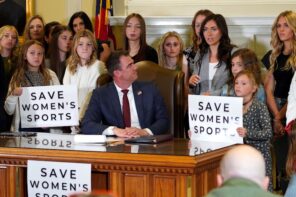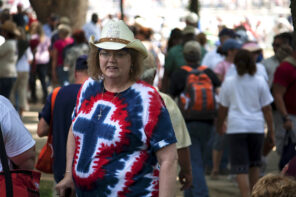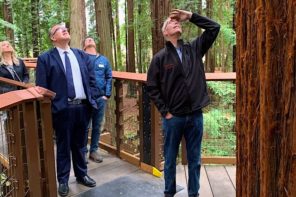When I was a small child, in the days before airbags and de rigueur seat belt wearing, I had a bit of a phobia of riding long distances in cars, particularly across bridges. My dad eventually cured me of this by introducing a compulsive distraction: counting. Rather than focusing on how fast we seemed to be going or how high over a rushing river we seemed to be slung, I counted red cars, blue cars, white cars; trucks, station wagons, sedans; light posts, fence posts, sign posts; and so on.
So it is that I learned this at an early age: numbers make us comfortable. They create the illusion that we understand something meaningful about the reality through which we are moving even as they distract us from the mysterious, often hidden, mechanisms propelling us through time and space.
Judging by the media excitement over the latest poll illustrating continued growth in the number of people who answer “none” when asked with what religion they are affiliated, the Pew Forum on Religion & Public Life seems to have pulled a similar trick for those interested in how religion is changing in America. “‘Nones’ On the Rise,” released on October 9 by Pew in affiliation with PBS’ Religion & Ethics NewsWeekly, gives the sense that we can see what’s really going on across the American religious landscape and understand it.
The following data points from the report, for instance, seem to make clear that America is growing less and less religious:
- Nearly one-fifth of the U.S. population (19.6%) is religiously unaffiliated—the highest percentage tracked in Pew polling;
- While Nones are most likely to be found among Millennials (32%), GenXers (21%) and Baby Boomers (15%) have likewise grown among the population of Nones;
- Fewer than half (48%) of American adults say they are Protestant—the first time self-identified Protestants have fallen below 50% in Pew surveys;
- More than two-thirds of Nones (68%) believe in God, with more than half (51%) praying on a regular basis;
- Two-thirds of those surveyed (66%) say religion is losing its influence in American life, with more than half citing an excessive focus on rules (51%) and an inappropriate concern with money and power (51%).
But do such data really tell us much about American religiosity—about religion as it is lived in the United States today? A number of what I would see as problems in the Pew report suggest to me that our growing fixation with religion-by-the-numbers may be distracting us from richer, more nuanced understandings of American religious practice.
Wanted: A Community that Doesn’t Share My Beliefs and Values
Take the demographic category of “Nones” itself. The Pew report notes the difficulty with survey questions which ask respondents to define their religious outlook in negative terms—“no religion,” “no religion in particular,” “none.” Such options, especially as they are used in demographic reporting, suggest that respondents are not in any way religious, that they do not have religious beliefs and do not engage in religious practices. We know that this is clearly not the case—that many Nones are believers of one sort or another, that they do engage in a range of religious or spiritual practices. Because of this, the researchers have preferred the term “religiously unaffiliated” to the more popularly used “None.”
But this terminology, too, is problematic, as it focuses on a particular, institutional, belief-based mode of spiritual association that reveals itself, as well, in the survey’s questions on community-seeking. Nones, the report states, “attach much less importance to belonging to a community of people with shared values and beliefs; 28% of the unaffiliated say this is very important to them, compared with 49% percent of all adults.” (Emphasis added.)
Does this mean that Nones eschew spiritual community? My own research for a forthcoming book on the spiritual lives of Religious Nones suggests otherwise. Though my research is very preliminary at this stage, the desire for community in which religious or spiritual concerns can be shared consistently emerges from interviews with self-identified Nones. That doesn’t, however, mean they’re looking for a community in which there are “shared values and beliefs” that would be expressed in doctrines or creeds.
Rather, especially among younger Nones raised in environments where religious pluralism and associated tolerance were regarded positively, finding community in which multiple points of view and diverse practices are welcomed is a commonly-reported desire. Among the Nones I’ve interviewed, “I don’t want to feel like I have to edit myself” is a frequent expression of a desire to find spiritual community not shaped primarily by assent to particular beliefs and values.
My hunch is that questions about “belonging to a community of people who share your beliefs and values” confuses the idea of community as a gathered social-spiritual network (a tribe) with the fraught subject of doctrinal religious belief and, further, the problematic language of religious values. We know, of course, that attendance at religious services of all sorts is down (except, perhaps, among religious groups in which doctrinal pluralism is something of a core value), but that does not allow us to conclude that religious or spiritual community is not important in the United States among those who identify or formally affiliate with institutional religions as well as those who do not.
Do You Believe in Yoga?
The Pew report likewise muddies the waters of American religiosity by consistently lumping Atheists (2.4%) with Agnostics (3.3%), often with perplexing results. For example, according to the report, some 7% in the combined “Atheist/Agnostic” group “think of themselves as a religious person.” While it’s undoubtedly fair to count the likes of Richard Dawkins or Bill Maher as religiously anti-religious Atheist evangelists, I have to suspect that the 7% of religious among the “Atheist/Agnostic” group, along with the 34% of their cohort who see themselves as “spiritual but not religious,” might be on the more Agnostic end of the spectrum.
Likewise, it’s hard to know, in the end, what to make of what seems a startling set of numbers related to “belief in God or a Universal Spirit.” Here, we learn what some 38% in the blended “Atheist/Agnostic” group says when asked about this belief. In commentary, the group is deconstructed, with 14% of Atheists and 56% of Agnostics expressing a belief in God of a Universal Spirit. We might well wonder what this could possibly mean, especially among self-identified Atheists. Did they not understand the question? Were they punking the researchers? But the bigger question, it seems to me, is how such a wide gap—a full 42% difference—would not suggest to someone on the research team that Atheists and Agnostics are not readily blended populations.
Finally, the numbers in the Pew report obscure an understanding of American religiosity as it is expressed in practice—that is, as people do religion or spirituality rather than as they believe. While the researchers marked practice in the conventional categories of worship attendance and prayer, other practices that my research has suggested are religiously or spiritually meaningful to Nones are approached largely through the frame of belief. Thus, respondents were asked not whether they practiced yoga or to what spiritual effect, but rather whether they “believe in yoga, not just as an exercise, but a spiritual practice.” (Emphasis added.) Here, yoga is situated among belief in “spiritual located energy in things such as mountains, trees, and crystals,” reincarnation, astrology, and the evil eye.
This fixation on religion in terms of belief shows up again in questions related to reflection on the meaning of life, connection with nature, and the value of religion itself. The bias here is plain: believing is the basis of religiosity. Practice matters only insofar as it expresses commitment to belief.
This belief-based orientation in the study of religiosity, and the study of religion more generally, obscures what is revealed again and again as a diverse and rich spiritual landscape. Respondents to a survey that I tested earlier this year, for instance, ranked “enjoying time with family,” “enjoying time with pets or other animals,” “enjoying time with friends,” and “preparing or sharing food” as among the most “spiritually meaningful practices” in an inventory that also included the conventionally-measured practices of “attending worship,” “studying sacred texts,” and “praying.” Only prayer made it to the top of the list, coming in at number five behind what I’ve come to call the “Four F’s of Contemporary American Spirituality”: Family, Fido, Friends, and Food. This ranking was consistent whether respondents identified as religiously-affiliated or not.
My work here, again, is only preliminary—a revised survey will be conducted later in the fall. But it does suggest, even at this early stage, that the “decline in religiosity” reported in surveys such as we’ve seen this week misses much of significance in American religious and spiritual life today. It teaches me, at least, that what counts in the study of religion is often far beyond what we can count.




